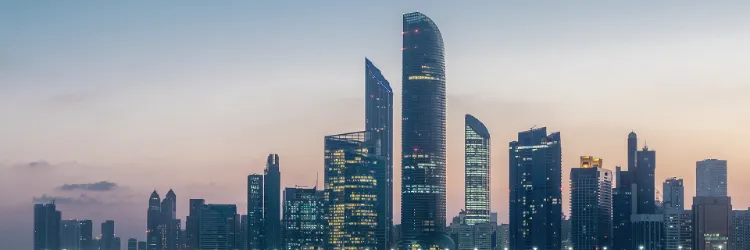The Middle East pivot to Asia is reshaping the global economic landscape

The global economic landscape has shifted eastward in recent years as the growing partnership between the Gulf Cooperation Council (GCC) and dynamic Asian economies gains momentum. What started as a straightforward exchange of oil for labour has been transformed into a complex web of collaboration spanning construction, renewables, finance, tourism and technology.
This is reflected in the growth of trade between the two regions. In 2022, GCC trade with Emerging Asia surged to USD516 billion and is projected to reach over USD750 billion by 2030, almost twice the figure in 2021, according to research by London-based think tank Asia House.
Notably, this eastward shift is outstripping the GCC’s trade with traditional Western partners. Trade with the US, UK and EU also grew over the same period, but at a more modest 32%, and Emerging Asia is set to become the GCC’s primary trading partner by 2026. This article looks at what’s changing, and why it matters.
Shifting trade patterns
China is a key driver. GCC-China trade has risen by around 50% over the last decade and now almost matches the GCC’s combined trade with the US, UK, and Western Europe. Saudi Arabia and the UAE’s accession into the Brazil, Russia, India, China and South Africa (BRICS) bloc in 2024 will place them closer to Chinese decision-making.
The GCC’s bilateral ties with other Asian nations are also strengthening. Assisted by the UAE-India Comprehensive Economic Partnership Agreement (CEPA), non-oil trade reached AED240 billion last year, showing what’s possible when shifts in trade policy, private capital and regional logistics align.
The UAE’s drive to broker CEPAs with ASEAN’s main powers could boost trade further. Hong Kong has further sought to deepen ties with the Gulf, becoming an increasingly important link for capital flows and business between the Gulf and Asia.
Trade between the GCC and Asia is becoming more diversified, more sector-driven and more strategically aligned. Under CEPA, the UAE and India have removed tariffs on key goods and streamlined customs procedures. Since implementation, UAE non-oil exports to India have grown by more than 75%, with significant gains in jewellery, food, machinery and electronics.
The same pattern is playing out elsewhere. Gulf states are reducing reliance on hydrocarbons, while Asian partners are building out new import sources and production networks. Agreements like CEPA are part of that, but so is long-term policy direction. India’s ‘Look West’ initiative and the UAE’s ‘We the UAE 2031’ vision both prioritise trade expansion beyond traditional sectors.
Strategic capital and cross-investment
Capital is moving both ways and it is doing so with more purpose. GCC sovereign wealth funds are no longer just passive investors in global assets. They are shaping long-term positions in Asian infrastructure, logistics and technology, often through joint ventures.
Mubadala Capital, a unit of the USD330 billion Abu Dhabi wealth fund ADQ, signed a memorandum of understanding for a partnership aimed at co-investments and other opportunities with Seviora, a subsidiary of Singapore state investment firm Temasek. Mubadala and another Singapore state investment firm GIC are also part of a USD7.3 billion deal to acquire German energy efficiency provider Techem, along with Switzerland’s Partners Group and TPG Rise Climate, the climate investing platform of US global alternative asset management firm TPG.
At the same time, Asian investors are looking outward. Banks, family offices and corporates from India, Singapore and South Korea are growing their presence in Gulf markets, whether through new funds, regional offices or joint developments.
The change is also institutional. Bilateral platforms and government-backed funds are now being set up not only to deploy capital, but to support shared strategic goals. Many are focused on sectors tied to long-term resilience, including supply chains, health, clean energy and agritech. The investments are structured to support long-term positioning in areas that matter to both sides.
New growth sectors reshaping trade
Trade is expanding well beyond traditional hydrocarbons, with new momentum in sectors tied to consumer demand, supply chain security and capital diversification. Gold is one of the standout examples. Under CEPA, gold jewellery exports from the UAE to India have more than doubled, driven by reduced tariffs and a more streamlined route through Dubai. That shift is also influencing logistics patterns, with more trade now routed through the Gulf’s customs hubs rather than older indirect corridors.
Food and pharma are also gaining ground, supported by investment in regional processing and cold chain infrastructure. Several Gulf-based conglomerates have moved into packaged foods and health products, often in partnership with Asian manufacturers and distributors.
Real estate and digital infrastructure are seeing a similar trend, especially in markets like Singapore, Vietnam and southern India, where Gulf investors are teaming up with local developers or tech funds. The model is evolving from export-only to embedded capital, with each deal reinforcing a more stable, sector-specific commercial relationship.
Talent, migration and regulatory bridges
Along with goods and capital, people and policy are also part of the flow between the two regions. More than 150,000 Golden Visas have now been issued in the UAE, with many going to professionals and entrepreneurs from India, Singapore and Southeast Asia that are looking to build regional bases. Many are choosing structures in Dubai International Financial Centre (DIFC) and Abu Dhabi Global Market (ADGM), the international financial centres that offer familiar legal systems and easier access to international clients.
Indian and Singaporean firms are among the most active, with cross-licensing options and dual-qualified advisers helping ease market entry. In many cases, teams are splitting operations across Asia and the Gulf, sharing staff, resources and regulatory approvals.
The recent trade agreements have added momentum, with provisions for professional mobility, dispute resolution and financial cooperation helping to remove friction and make it easier for firms to scale across borders.
What this means for business
The landscape is broadening. Gulf–Asia ties now cut across sectors, investment models and regulatory systems. Trade is deeper, capital is more strategic, and mobility is reshaping how businesses operate across borders.
For firms active in the region, older assumptions may no longer hold. Energy remains key but is no longer the sole focus. New opportunities are forming in sectors once seen as peripheral.
Trade and capital flows are being reshaped by policy, sector dynamics and long-term planning. The businesses that adapt early are likely to be best placed to navigate what comes next.
Explore opportunities in the GCC–Asia corridor
Sovereign PPG supports businesses, investors and family offices navigating cross-border expansion, structuring and regulatory compliance across the Gulf and in key Asian markets. Whether you are assessing new partnerships, setting up operations or managing cross-jurisdictional assets, our team offers practical, on-the-ground support.
To speak with Sovereign PPG, call +971 (0)4 456 1761 for Dubai or +971 (0)2 448 5120 for Abu Dhabi.
You can also email to sovppg@SovereignGroup.com or use the contact form below.

